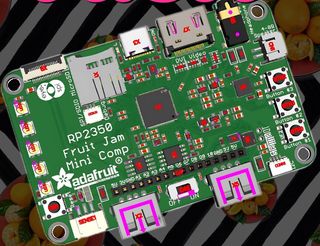Adafruit’s Fruit Jam is a Raspberry Pi Pico 2 powered, credit card sized computer
One of the coolest things about the Raspberry Pi is all of the cool third-party boards that get made by the community and professional companies like Adafruit. Today we’re excited to share a cool design put together by the team over at Adafruit featuring the Raspberry Pi Pico 2’s RP2350B microprocessor. In a blog post uploaded earlier this week, we get a close look at a new board design called the Fruit Jam RP2350B.
This mini credit card-sized computer was inspired by another board known as the IchigoJam. This board is Raspberry Pi Pico compatible and proved to be a handy little device with plenty of wiggle room for modification. The two boards are similar in that they are Pico-powered but Adafruit’s Fruit Jam board incorporates everything you need in one board to turn it into a functional tiny 8-bit style computer.
The IchigoJam is a $15 pocket sized computer that originally was designed to work with the NXP LPC1114F microcontroller but has since been upgraded to support the Raspberry Pi Pico. The IchigoJam offers composite video output support and can use PS/2 keyboards with a USB adapter. This got Adafruit thinking that the board would be fun to recreate with a few additional tweaks to make it a useful tiny computer.

The Fruit Jam design from Adafruit includes quite a bit of hardware to play with including two USB A ports, NeoPixels, several buttons, StemmaQT and even a speaker connection via JST and a 3.5mm audio jack. There are a smattering of GPIO pins, including analog pins and digital (which will also likely feature PWM)
You can connect a monitor using a DVI port and use its microSD card slot for storage. The Fruit Jam board is planned to be powered by an RP2350B with 8MB of PSRAM, as well as the default 520KB of SRAM. Onboard storage comes with 16MB of QSPI flash.
It’s not confirmed what programming language will be used to program the Fruit Jam but we imagine that CircuitPython will be the first choice. However we know for sure that it includes a USB-C port that will be used for power and for flashing firmware to the board. How you use Fruit Jam, we have to guess that it will follow the 1980s home computer trend of powering on, and being presented with a prompt. Something that CircuitPython lead developer Scott Shawcroft talked about in an episode of our show The Pi Cast back in 2021.
For comparison, the IchigoJam is designed to be programmed in BASIC, yes a similar BASIC to what many of us used on hour home computers in 1970s and 80s.
If you want to get a closer look at this Raspberry Pi project, you can check out the full blog post shared by Adafruit for more details.
#Adafruits #Fruit #Jam #Raspberry #Pico #powered #credit #card #sized #computer
